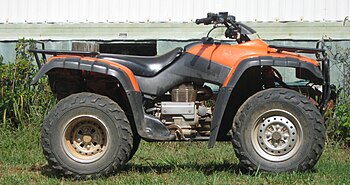The ATVs (all terrain vehicles) we know today had very humble beginnings in the mountainous farming regions of Japan. The muddy mountain roads became difficult for the farmers to travel during spring thaws and were almost impossible to drive over with conventional vehicles or big machinery. The Japanese, always a culture to modify and tinker with something until they could improve it, created the three wheeled ATV. This vehicle did wonders for helping the local farmers. The ATVs were less expensive than the larger farm vehicles and it proved to be an excellent little workhorse.
 |
| Honda Ranger ATV (Photo credit: Wikipedia) |
Over thirty years ago the Honda US90 made its debut and was called the ATC90. Oddly enough, the initial intent of the ATVs may have started out at the opposite end of the spectrum from Japan’s working class ATV, but in the end, the results were the same. After gaining popularity as a recreational vehicle, the ATV soon became popular as a working vehicle as Americans began to realize exactly how versatile this little three-wheeled vehicle could be.
The ATV proved to have several advantages for the working class man. First and foremost, the ATV was cheaper to operate than a tractor or pickup truck and during the gas crunch of the 70’s, that was a big plus. The ATV was also easier to maneuver in tight spots and could travel over practically any type of terrain. The only problem people found was the tires. The tires of earlier ATVs were low-pressure and while this worked fine on mud or sand, the tires punctured easily when going over sharper terrain, like a harvested field or sharp rocks. Overall, the ATV did work that no other piece of heavy equipment could do. The original tires weren’t repairable either.
In 1975 the hubless wheel design was replaced with steel hubs and a wheel lined with a tough fabric on the inside. More durable plastic fenders were added. This time they produced fenders in bright colors for better visibility out in the bush. As the ATV’s popularity grew the Japanese engineers didn’t stop their research and development. They had a good thing going and they were determined to make it better. Their engineers went into the field to see how the ATV’s performed and started gathering data to help with the next round of modifications.
By the 1980’s, ATVs had gone the same route as dirt bikes and motorcycles. The ATV’s were being used as a utility vehicle and for racing. More and more people were buying ATV’s for riding off road trails and competing in races similar to motocross events. By 1985 ATV usage had gone from only 30% in the 70’s to the whopping 80%. In 1988, Honda made another groundbreaking leap with the ATV’s design, the introduced the FourTrax 300 and a second model called the FourTrax 300 4x4. Up until this point the ATV still had the three wheels, now Honda added an extra wheel and gave the ATV four wheel drives, which provided more stability and power. They also fitted the FourTrax with a four stroke single cylinder engine which was air cooled and gave it a five-speed transmission, automatic clutch and a maintenance free drive shaft. Honda also thought to give the FourTrax an extra low gear for hauling particularly heavy objects as big as 850 lbs.
Today, ATV’s are fully ingrained into our way of living. You can find ATVs on the dirt bike trails, on farms, on construction sites and a host of other places. Now countries all over the world are discovering the same thing Americans have; the ATV is a fun and efficient vehicle for handling a wide array of jobs in almost any environment.
No comments:
Post a Comment